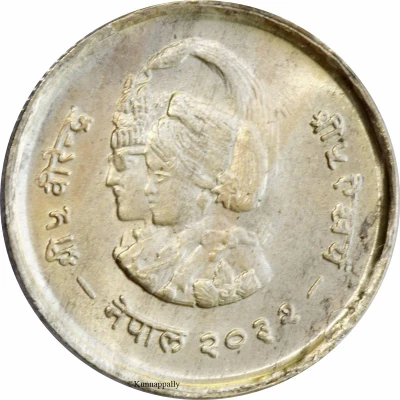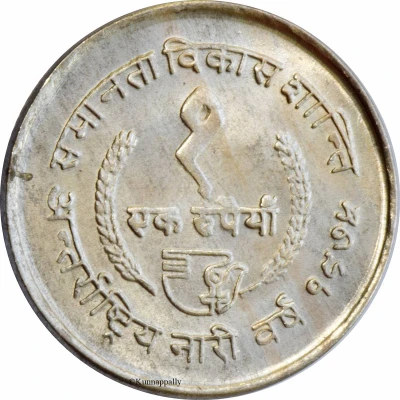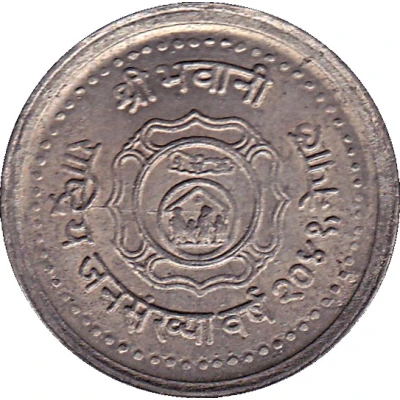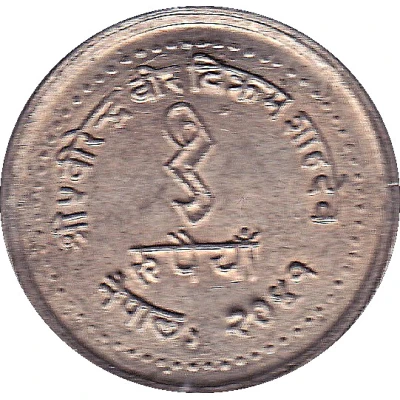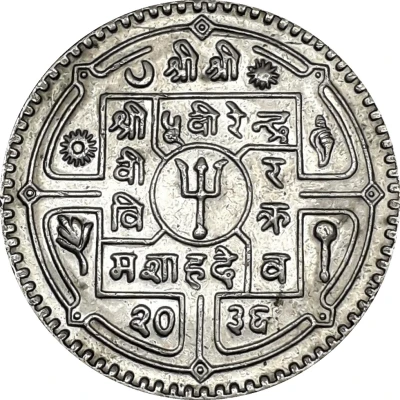
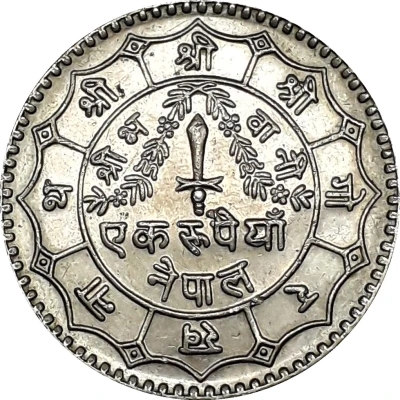

© nordboutik59
1 Rupee - Birendra Bir Bikram
| Copper-nickel | 7.5 g | 27 mm |
| Issuer | Nepal |
|---|---|
| King | Birendra Bir Bikram Shah (1972-2001) |
| Type | Standard circulation coin |
| Years | 2033-2036 (1976-1979) |
| Calendar | Vikram Samvat |
| Value | 1 Rupee 1 NPR = USD 0.0074 |
| Currency | Rupee (1932-date) |
| Composition | Copper-nickel |
| Weight | 7.5 g |
| Diameter | 27 mm |
| Thickness | 1.70 mm |
| Shape | Round |
| Technique | Milled |
| Orientation | Medal alignment ↑↑ |
| Updated | 2024-10-06 |
| Numista | N#26252 |
|---|---|
| Rarity index | 8% |
Reverse
Script: Devanagari
Lettering:
श्री श्री श्री गो र ख ना थ
श्री भवानी
एक रूपैयाँ
नेपाल
Unabridged legend:
Shri Shri Shri Gorakhnath
Shri Bhawani
Ek Rupiya
Translation: See comments section below
Edge
Reeded
Comment
weight: 7.52 - 7.65thickness: 1.8 mm (2036), 1.96 mm (2034)
NOTE: issues of 2036 were struck by the Canberra Mint with a very shiny surface. High quality 2034 issues were struck by Canberra Mint, dull surfaced ones were probably struck at Kathmandu Mint.
Meaning of words used on the coin:
1. Shri is a polite form of address equivalent to the English "Mr.". Shri is also frequently used as an epithet of some Hindu gods, in which case it is often translated into English as holy.
2. Shri Panch is the once revered crown worn by Nepal's Shah dynasty kings, who were called 'Shri Panch', a reference to their sway over five kingdoms. The crown is easily identifiable because of the long, bird of paradise plume descending from the jewel-studded ornament at the apex of the turban-like crown.
3. Shahdev is derived from two Sanskrit words shaha (सह) and deva (देव). Saha means with and deva is a Hindu term used for deity. So literally, Sahadeva means with Gods
4. Shri Gorakhnath (also known as Goraksanath, c. early 11th century) was a Hindu yogi, saint who was the influential founder of the Nath Hindu monastic movement in India. Hagiographies describe him as more than a human teacher and someone outside the laws of time who appeared on earth in different ages. The Gurkhas get their name from him. Shah dynasty kings of Nepal were a devotee of Guru Gorakhnath.
5. Shri Bhawani refers to Taleju Bhawani. Taleju Bhawani is considered as the goddess who made kings. Legend has it that the great Malla kings established their powerful dynasty because they were granted kingship by goddess Taleju. There are Taleju temples in the three royal palaces of Malla Kings in Basantapur, Patan and Bhaktapur. When King Prithvi Naryan Shah conquered the three kingdoms of Kathmandu valley, he continued the tradition of worshipping the goddess Taleju and the living goddess Kumari, a child manifestation of the goddess.
Interesting fact
One interesting fact about this coin is that it features a unique combination of Hindu and Buddhist symbols, reflecting the cultural diversity of Nepal. The coin's obverse side bears the image of the national emblem of Nepal, which includes a rhino, a crescent moon, and a sun, while the reverse side features the portrait of King Birendra Bir Bikram Shah Dev. This blend of religious and cultural symbols highlights the country's rich history and heritage.
Price
| Date | Mintage | VG | F | VF | XF | AU | UNC |
|---|---|---|---|---|---|---|---|
| 2033 (1976) | 58000 | - | - | - | - | - | - |
| 2034 (1977) | 30000000 | - | - | - | - | - | - |
| 2036 (1979) | 30000000 | - | - | - | - | - | - |
Values in the table are based on evaluations by sales realized on Internet platforms. They serve as an indication only for 1 Rupee - Birendra Bir Bikram 2033-2036 (1976-1979) coin.
